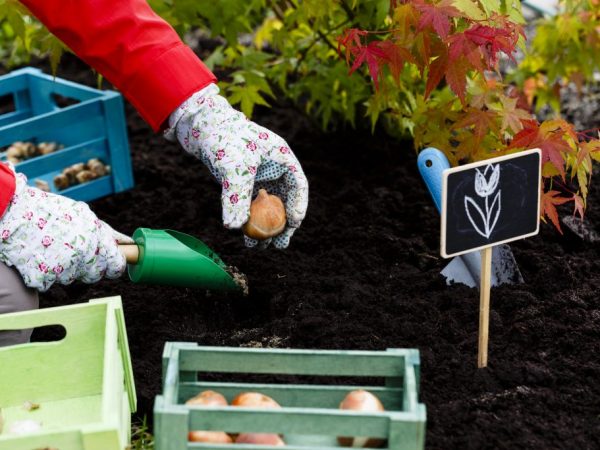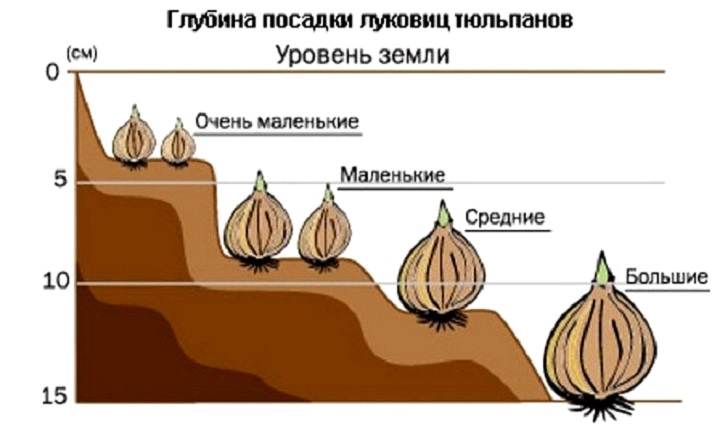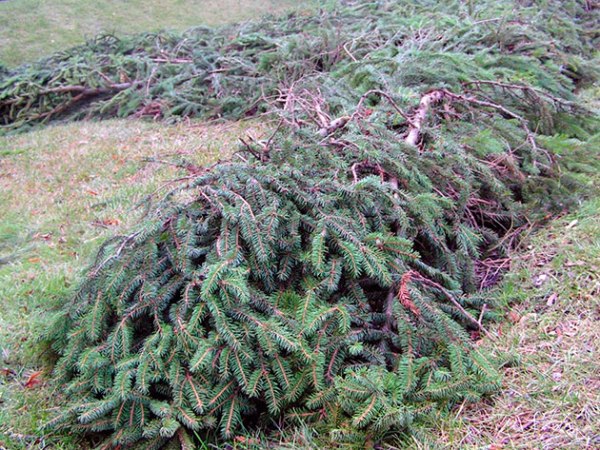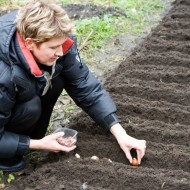Features and benefits of planting tulips in open ground in the fall
Content
Benefits of planting tulips in autumn
You can plant bulbous flowers in open ground in both spring and autumn. However, according to experienced gardeners, autumn planting has more benefits. In the autumn, when nature is actively preparing for the upcoming winter, tulips are activated in growth and development. The bulbs planted in the soil intensively absorb useful and nutrient substances from the soil. The root system is naturally hardened. At the end of the winter cold, the flowers throw out powerful arrows and delight with abundant and long flowering.

The bulbs planted in spring do not have time to build up a powerful root system. Flowering will be late and very poor. The buds are small, the shades of flowers are muted, the stems are thin and weak. In some cases, flowering is completely absent.
You can only dig up tulip bulbs when most of the leaf plate is dry. The rhizomes extracted from the ground are cleaned of the remnants of foliage and clods of earth, carefully dried and sent to storage in a shaded and well-ventilated place. We do not recommend covering the container with bulbs with cloth or gauze. Lack of fresh air can cause tubers to rot.
Video "Autumn planting of tulips"
In this video, experts talk about the peculiarities of planting bulbs in open ground.
Ideal dates for planting tulips in autumn
The speed of adaptation and the survival rate of bulbs planted in the fall depend on adherence to the planting dates. Late planting is fraught with the death of flowers. The tubers do not have time to adapt to the new growing environment. At the first frost, they freeze over and begin to rot.
Therefore, it is necessary to plant tulips in open ground at certain times, which differ for different regions.

Middle lane and Moscow region
The moderate continental climate of central Russia is characterized by snowy winters and frequent temperature changes. The planting of tulips in the regions of central Russia, including the Moscow region and the Leningrad region, falls almost in the middle of autumn. They begin to plant bulbous flowers in the last decade of September, finish - closer to mid-October. In this case, the air temperature at night should be at least +3 ° C.
Siberia and the Urals
They start planting tulips in Siberia early - in the last decade of August. Such an early planting of tubers is due to the climatic zone of the region. The planted plants should have time to take root before the first frosts, which come very early in Siberia.
As for the Urals, the timing of planting tulips depends on a specific area. So, in the northern part of the region, tubers are planted in open ground in mid-September. In the southern part of the Urals, the planting of an ornamental culture may take until the second decade of October.
Central regions
The central regions of the country are characterized by rainy and damp autumn. The first night frosts occur at the end of September, and sleet at the beginning of October. For this reason, tulips are planted in the first month of autumn. Flowers planted in October may not take root and freeze with the first frosts.

South of the country
The southern regions, including the Stavropol Territory, Kuban, Crimea, Krasnodar Territory, Volgograd, Astrakhan and Rostov Regions, are distinguished by warm and mild winters. Bulbous plants can be planted from mid-September to the second decade of October.
If the autumn is dry and hot, the flower tubers planted in the ground must be thoroughly moistened. For this, water-charging irrigation is carried out.
How to plant tulips correctly
Timing of landing is only half the battle. It is equally important to know how to properly plant tulip bulbs outdoors in the fall.
Site and soil selection
Tulips are demanding on the place of constant growth. It is better to plant bulbous flowers in higher elevations. If you plant the plants in a low-lying area, where melt water or rainwater often collects, there is a high likelihood of rotting tubers. Also, the close occurrence of groundwater is undesirable.
The best option is a section of the garden open to sunlight and well protected from wind and drafts. Please note that a lack of sun negatively affects the intensity and duration of the plant's flowering.
Loose, airy and fertile soil is suitable for planting bulbs. The acidity level should be in the range of 6.5-7.8 pH. Heavy clay soil should be diluted with river sand, peat and manure (5 kg per 1 m²). Adding sand and organic matter will help increase the permeability and nutritional value of heavy soils.
Land preparation
Since tulips grow well and bloom profusely in a nutrient medium, it is recommended to prepare the site in advance. First, the area is cleared of weeds, then they begin to improve the soil composition. 1 m² of land requires:
- wood ash - 150-200 g;
- potassium sulfate - 30 g;
- ammonium nitrate - 25 g;
- superphosphate - 40-50 g;
- compost - 2 buckets.
Fertilizers are applied to the soil 2–4 weeks before planting. If the weather is dry and hot, the soil should be well moistened and leveled with a rake. Loose and slightly damp soil promotes rapid rooting of tubers.
Planting tulip bulbs
You can plant tulip bulbs in rows or in holes. The distance between the rows is 20-25 cm, between the holes - 6-10 cm.
- Into the holes
- In the beds
- Landing patterns
The penetration depth depends on the class of the planting material. Extra-class bulbs are buried by 15-18 cm, the second and third parsing - by 10-12 cm. Tulip babies are planted to a depth of 6-8 cm.
The planted bulbs are sprinkled with river sand and wood ash. Now the beds / holes are covered with earth. Failure to comply with the planting technology will lead to the loss of planting material. To avoid water accumulation, the beds / holes are carefully leveled with a rake. A drainage system is formed around the flower bed to remove excess moisture.

Planting care
The first watering is carried out 10 days after planting the bulbs. Watering the flowerbed from a watering can. On the second or third watering, fertilizing with ammonium nitrate is performed. 15 g of the preparation is required for 1 m² of a flower bed.
Planting maintenance involves removing weeds and loosening the topsoil. It is not necessary to cover bulbous crops with mulch, since an increase in temperature can provoke premature growth of tubers.
Preparing for winter
Towards the beginning of winter, the tulip beds begin to prepare for the upcoming frost. Bulbous crops are insulated with a layer of straw, hay, dry fallen leaves and crushed cardboard. The height of the covering layer must be at least 5 cm.Pine branches are laid on top of the insulating layer.
You can cover tulip bulbs with white propylene bags, old burlap or agrofibre.

Useful Tips
Simple tips and advice from experienced gardeners will help speed up adaptation and increase the germination rate of bulbous crops. When choosing a place for planting tulips, you need to take into account the predecessors. If earlier tomatoes, cucumbers, zucchini, melons or watermelons grew on these beds, it is better to find another place for planting bulbous crops. To destroy pathogenic bacteria and harmful organisms, the soil is treated with a weak solution of potassium permanganate or fungicides diluted with water.
Don't forget about replanting tulips. Varietal crops are transplanted to a new place of annual growth, unpretentious varieties - once every 2-3 years. Planting in the same place of growth is possible after 3-4 years.
Autumn planting of tulips in open ground requires the attention and responsibility of gardeners. Incorrectly selected dates and non-compliance with planting technology will lead to freezing of the bulbs.



